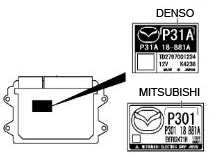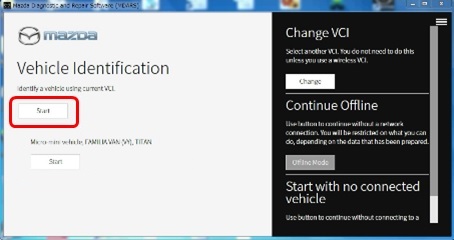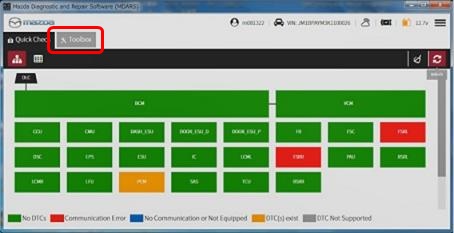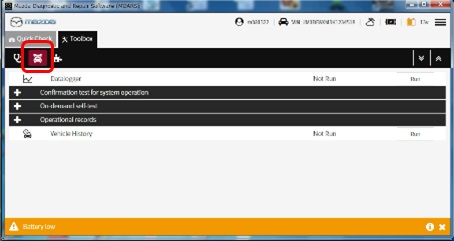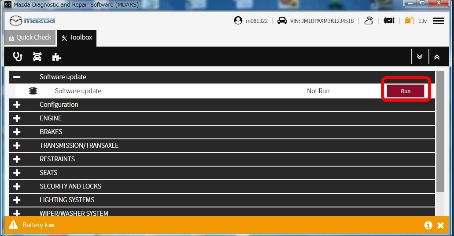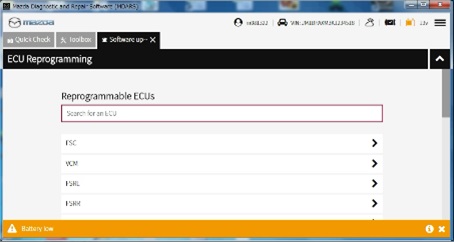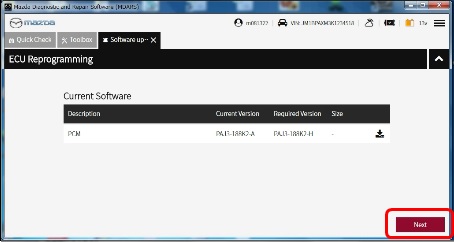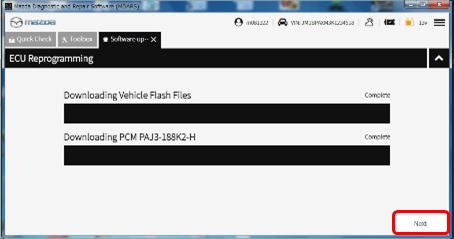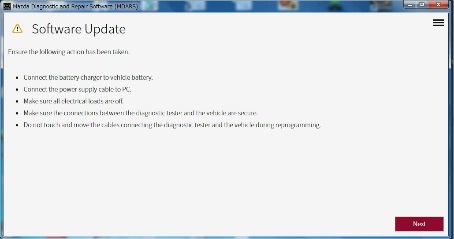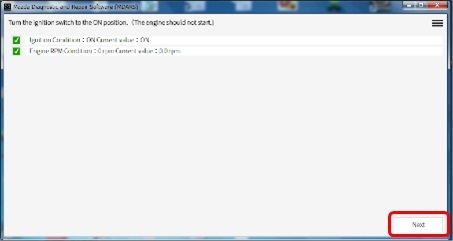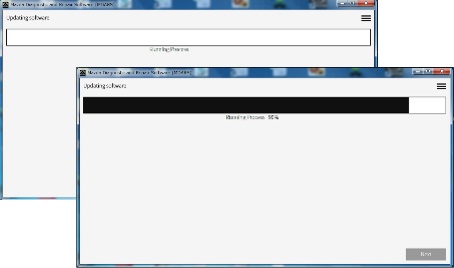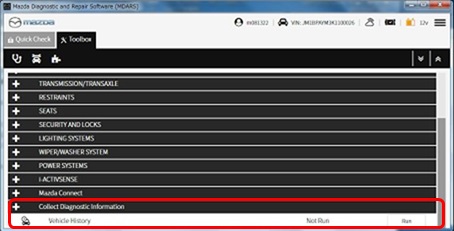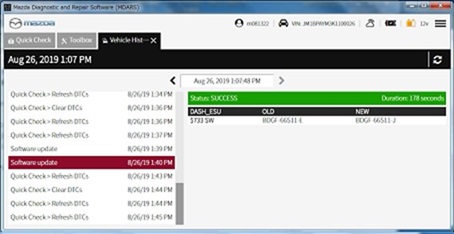TSB NUMBER: 15-20-01
TSB ISSUE DATE
05/02/2020
BULLETIN NOTES
APPLICABLE MODEL(S)/VINS
2019-2020 Mazda3 vehicles (Japan built/US spec) with VINS lower than JM1BP******147796 (produced before July 2, 2019)
2019-2020 Mazda3 vehicles (Japan built/Mexico spec) with VINS lower than JM1BP******151056 (produced before Aug 10, 2019)
2019-2020 Mazda3 vehicles (Mexico built/US spec) with VINS lower than 3MZBP******115266 (produced before July 2, 2019)
2019-2020 Mazda3 vehicles (Mexico built/Mexico spec) with VINS lower than 3MZBP******119398 (produced before Aug 10, 2019)
DESCRIPTION
Some customers may complain about a shift shock and/or an engine RPM increase when setting the Mazda Radar Cruise Control (MRCC) system with no DTCs being stored.
NOTE: This concern only occurs on vehicles equipped with a PCM manufactured by MITSUBISHI.
| PCM Identification |
 |
This is caused by improper control logic of the PCM allowing the engine RPM increase for an instant right after setting the MRCC. To correct this issue, the PCM software has been modified.
Customers having this concern should have their vehicle repaired using the following repair procedure.
REPAIR PROCEDURE
1. Verify customer conern.
NOTE: If any DTCs relating to engine or transmission are stored, this TSB is not applicable. Diagnose the DTCs according to the appropriate troubleshooting instructions on MGSS.
2. Verify if the PCM in the subject vehicle is manufactured by MITSUBISHI.
- If yes, proceed to the next step.
- If no, this TSB does not apply.
3. Reprogram the PCM using the Mazda Diagnostic And Repair Software (MDARS). Refer to “MDARS – ECU Reprogramming Procedure”.
NOTE:
- If the current calibration file name in the ECU FILENAME screen is the same as shown in the Calibration Files Information or with a later suffix, reprogramming is not necessary.
- After reprogramming, pending DTC P2610:00 [PCM] will be stored without the Check Engine Light ON. Start the engine and clear the DTC.
- After reprogramming, if DTC U2120:00 and/or U2500:82 are stored and the i-ACTIVSENSE warning light (amber) turns ON, refer to SA-036/19.
4. Clear the DTC, turn the ignition off, and get out of the vehicle.
5. Close and lock the door.
6. Wait for at least ten minutes.
7. Verify the repair by starting the engine and making sure that all warning lights are off.
NOTE: If any DTCs should remain after performing DTC erase, diagnose the DTCs according to the appropriate troubleshooting instructions on MGSS.
MDARS ECU Reprogramming Procedure
NOTE: This procedure explains a generic reprogramming for all Electrical Control Units (ECU) such as PCM, BCM, ESU, etc. Be aware that some sentences and screen shots below mention a certain control unit such as “PCM” or “BCM” as an example.
ATTENTION: READ ALL CAUTIONS AND NOTES BEFORE AND AFTER REPROGRAMMING!
CAUTION:
- A poor connection between the vehicle and M-MDS and/or low voltage may result in abnormal termination and/or data corruption. A low battery voltage may cause a reprogramming failure resulting in unexpected ECU replacement.
- Make sure that the following connections are firmly connected, then DO NOT touch the VCM and DLC cable to prevent noise and a poor connection.
- Between the vehicle-side connector and the DLC cable
- Between the PC-side connector and the USB port of the PC
- When reprogramming with MDARS, power consumption and voltage fluctuation are greater than with IDS. Connect the GR8 battery charger and use Manual Mode set to 14.5 volts with no more than 10-15A charging current to the vehicle to minimize any voltage fluctuation.
BEFORE REPROGRAMMING
NOTE:
- Turn off all electrical loads (i.e. A/C blower, audio system, rear defogger and headlights).
- Perform a self-test and verify no DTCs are stored. If any DTCs are stored, repair the concern and delete the DTCs.
- Disconnect any aftermarket accessories (non-genuine Mazda accessories).
- Terminate all programs other than MDARS on the PC. Running other programs may interfere with the MDARS performance, resulting in the PC freezing or other problems.
- Perform reprogramming with a proper internet connection. When using a wireless network, make sure the connection is strong.
- Make sure to keep enough free space on the PC’s hard disc. Insufficient free space (less than 1 GB) may result in the PC freezing during reprogramming.
1. Connect the M-MDS to the vehicle.
2. Launch the Mazda Diagnostic And Repair Software (MDARS).
3. Turn the ignition on, then click “Start”.

4. Select the “toolbox” tab.

5. Select Work Support group.

6. Select “Software update”, then click “Run”.

7. Select the ECU to be reprogrammed.

8. Confirm the current and new software versions, then click “Next”.
NOTE: When reprogramming the BCM, two softwares will be shown.

9. Wait for the download, then click “Next”. NOTE: When reprogramming the BCM, downloading will occur twice.

10. Read the screen instructions, then click “Next”.

11. Follow the instructions on the screen, then click “Next”.

12. Wait for the reprogramming to complete.
NOTE:
- The progress bar will stay at 90% for 30 seconds. This is not a failure.
- When reprogramming the BCM, this process will occur twice.

AFTER REPROGRAMMING
NOTE:
- Select “Vehicle History” under “Collect Diagnostic Information”, then click “Run”.

- Confirm the reprogramming on the screen and save the screen copy as a record.

CALIBRATION
US spec.
Japan built
| Engine |
Trans-
mission |
Drive |
File Name |
Cylinder Deactivation |
| 2.0L |
MT |
2WD |
PAJ2-188K2-H |
– |
| AT |
2WD |
PAH9-188K2-H |
– |
| 2.5L |
MT |
2WD |
PX58-188K2-H |
X |
| AT |
2WD |
PXJ7-188K2-C |
– |
| PX05-188K2-J |
X |
| 4WD |
PX07-188K2-L |
X |
Mexico built
| Engine |
Trans-
mission |
Drive |
File Name |
Cylinder Deactivation |
| 2.0L |
MT |
2WD |
PAK1-188K2-D |
– |
| AT |
2WD |
PAJ8-188K2-D |
– |
| 2.5L |
AT |
2WD |
PXK5-188K2-B |
– |
| PX13-188K2-D |
X |
| 4WD |
PX15-188K2-E |
X |
Mexico spec.
Japan built
| Engine |
Trans-
mission |
File Name |
| 2.0L |
AT |
PAJ4-188K2-H |
| 2.5L |
MT |
PX11-188K2-H |
| AT |
PX09-188K2-H |
Mexico built
| Engine |
Trans-
mission |
File Name |
| 2.5L |
MT |
PX19-188K2-E |
| AT |
PX17-188K2-E |
WARRANTY INFORMATION
NOTE:
- This warranty information applies only to verified customer complaints on vehicles eligible for warranty repair.
- This repair will be covered under Fed Emission Warranty or CA Emission Warranty (short term).
- Additional diagnostic time cannot be claimed for this repair.
| Warranty Type |
0 |
| Symptom Code |
64 |
| Damage Code |
9W |
| Part Number Main Cause |
5555-18-881 |
| Quantity |
0 |
| Operation Number / Labor Hours: |
XXRC2XFX / 0.2 Hrs. |
APPLICABLE MODEL(S)/VINS
2019-2020 Mazda3 vehicles (Japan built/US spec) with VINS lower than JM1BP******147796 (produced before July 2, 2019)
2019-2020 Mazda3 vehicles (Japan built/Mexico spec) with VINS lower than JM1BP******151056 (produced before Aug 10, 2019)
2019-2020 Mazda3 vehicles (Mexico built/US spec) with VINS lower than 3MZBP******115266 (produced before July 2, 2019)
2019-2020 Mazda3 vehicles (Mexico built/Mexico spec) with VINS lower than 3MZBP******119398 (produced before Aug 10, 2019)
Some customers may complain about a shift shock and/or an engine RPM increase when setting the Mazda Radar Cruise Control (MRCC) system with no DTCs being stored.
NOTE: This concern only occurs on vehicles equipped with a PCM manufactured by MITSUBISHI.
| PCM Identification |
 |
This is caused by improper control logic of the PCM allowing the engine RPM increase for an instant right after setting the MRCC. To correct this issue, the PCM software has been modified.
Customers having this concern should have their vehicle repaired using the following repair procedure.
1. Verify customer conern.
NOTE: If any DTCs relating to engine or transmission are stored, this TSB is not applicable. Diagnose the DTCs according to the appropriate troubleshooting instructions on MGSS.
2. Verify if the PCM in the subject vehicle is manufactured by MITSUBISHI.
- If yes, proceed to the next step.
- If no, this TSB does not apply.
3. Reprogram the PCM using the Mazda Diagnostic And Repair Software (MDARS). Refer to “MDARS – ECU Reprogramming Procedure”.
NOTE:
- If the current calibration file name in the ECU FILENAME screen is the same as shown in the Calibration Files Information or with a later suffix, reprogramming is not necessary.
- After reprogramming, pending DTC P2610:00 [PCM] will be stored without the Check Engine Light ON. Start the engine and clear the DTC.
- After reprogramming, if DTC U2120:00 and/or U2500:82 are stored and the i-ACTIVSENSE warning light (amber) turns ON, refer to SA-036/19.
4. Clear the DTC, turn the ignition off, and get out of the vehicle.
5. Close and lock the door.
6. Wait for at least ten minutes.
7. Verify the repair by starting the engine and making sure that all warning lights are off.
NOTE: If any DTCs should remain after performing DTC erase, diagnose the DTCs according to the appropriate troubleshooting instructions on MGSS.
MDARS ECU Reprogramming Procedure
NOTE: This procedure explains a generic reprogramming for all Electrical Control Units (ECU) such as PCM, BCM, ESU, etc. Be aware that some sentences and screen shots below mention a certain control unit such as “PCM” or “BCM” as an example.
ATTENTION: READ ALL CAUTIONS AND NOTES BEFORE AND AFTER REPROGRAMMING!
CAUTION:
- A poor connection between the vehicle and M-MDS and/or low voltage may result in abnormal termination and/or data corruption. A low battery voltage may cause a reprogramming failure resulting in unexpected ECU replacement.
- Make sure that the following connections are firmly connected, then DO NOT touch the VCM and DLC cable to prevent noise and a poor connection.
- Between the vehicle-side connector and the DLC cable
- Between the PC-side connector and the USB port of the PC
- When reprogramming with MDARS, power consumption and voltage fluctuation are greater than with IDS. Connect the GR8 battery charger and use Manual Mode set to 14.5 volts with no more than 10-15A charging current to the vehicle to minimize any voltage fluctuation.
BEFORE REPROGRAMMING
NOTE:
- Turn off all electrical loads (i.e. A/C blower, audio system, rear defogger and headlights).
- Perform a self-test and verify no DTCs are stored. If any DTCs are stored, repair the concern and delete the DTCs.
- Disconnect any aftermarket accessories (non-genuine Mazda accessories).
- Terminate all programs other than MDARS on the PC. Running other programs may interfere with the MDARS performance, resulting in the PC freezing or other problems.
- Perform reprogramming with a proper internet connection. When using a wireless network, make sure the connection is strong.
- Make sure to keep enough free space on the PC’s hard disc. Insufficient free space (less than 1 GB) may result in the PC freezing during reprogramming.
1. Connect the M-MDS to the vehicle.
2. Launch the Mazda Diagnostic And Repair Software (MDARS).
3. Turn the ignition on, then click “Start”.

4. Select the “toolbox” tab.

5. Select Work Support group.

6. Select “Software update”, then click “Run”.

7. Select the ECU to be reprogrammed.

8. Confirm the current and new software versions, then click “Next”.
NOTE: When reprogramming the BCM, two softwares will be shown.

9. Wait for the download, then click “Next”. NOTE: When reprogramming the BCM, downloading will occur twice.

10. Read the screen instructions, then click “Next”.

11. Follow the instructions on the screen, then click “Next”.

12. Wait for the reprogramming to complete.
NOTE:
- The progress bar will stay at 90% for 30 seconds. This is not a failure.
- When reprogramming the BCM, this process will occur twice.

AFTER REPROGRAMMING
NOTE:
- Select “Vehicle History” under “Collect Diagnostic Information”, then click “Run”.

- Confirm the reprogramming on the screen and save the screen copy as a record.

US spec.
Japan built
| Engine |
Trans-
mission |
Drive |
File Name |
Cylinder Deactivation |
| 2.0L |
MT |
2WD |
PAJ2-188K2-H |
– |
| AT |
2WD |
PAH9-188K2-H |
– |
| 2.5L |
MT |
2WD |
PX58-188K2-H |
X |
| AT |
2WD |
PXJ7-188K2-C |
– |
| PX05-188K2-J |
X |
| 4WD |
PX07-188K2-L |
X |
Mexico built
| Engine |
Trans-
mission |
Drive |
File Name |
Cylinder Deactivation |
| 2.0L |
MT |
2WD |
PAK1-188K2-D |
– |
| AT |
2WD |
PAJ8-188K2-D |
– |
| 2.5L |
AT |
2WD |
PXK5-188K2-B |
– |
| PX13-188K2-D |
X |
| 4WD |
PX15-188K2-E |
X |
Mexico spec.
Japan built
| Engine |
Trans-
mission |
File Name |
| 2.0L |
AT |
PAJ4-188K2-H |
| 2.5L |
MT |
PX11-188K2-H |
| AT |
PX09-188K2-H |
Mexico built
| Engine |
Trans-
mission |
File Name |
| 2.5L |
MT |
PX19-188K2-E |
| AT |
PX17-188K2-E |
NOTE:
- This warranty information applies only to verified customer complaints on vehicles eligible for warranty repair.
- This repair will be covered under Fed Emission Warranty or CA Emission Warranty (short term).
- Additional diagnostic time cannot be claimed for this repair.
| Warranty Type |
0 |
| Symptom Code |
64 |
| Damage Code |
9W |
| Part Number Main Cause |
5555-18-881 |
| Quantity |
0 |
| Operation Number / Labor Hours: |
XXRC2XFX / 0.2 Hrs. |
